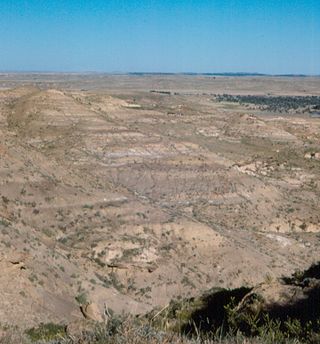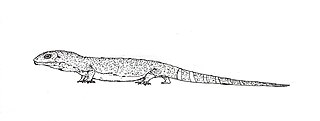
Amphiuma is a genus of aquatic salamanders from the United States, the only extant genus within the family Amphiumidae. They are colloquially known as amphiumas. They are also known to fishermen as "conger eels" or "Congo snakes", which are zoologically incorrect designations or misnomers, since amphiumas are actually salamanders, and not fish, nor reptiles and are not from Congo. Amphiuma exhibits one of the largest complements of DNA in the living world, around 25 times more than a human.

The Lissamphibia is a group of tetrapods that includes all modern amphibians. Lissamphibians consist of three living groups: the Salientia, the Caudata, and the Gymnophiona.

The Cryptobranchidae are a family of large salamanders that are fully aquatic. The family includes some of the largest living amphibians. They are native to China, Japan, and the eastern United States. Giant salamanders constitute one of two living families—the other being the Asiatic salamanders belonging to the family Hynobiidae—within the Cryptobranchoidea, one of two main divisions of living salamanders.

The Green River Formation is an Eocene geologic formation that records the sedimentation in a group of intermountain lakes in three basins along the present-day Green River in Colorado, Wyoming, and Utah. The sediments are deposited in very fine layers, a dark layer during the growing season and a light-hue inorganic layer in the dry season. Each pair of layers is called a varve and represents one year. The sediments of the Green River Formation present a continuous record of six million years. The mean thickness of a varve here is 0.18 mm, with a minimum thickness of 0.014 mm and maximum of 9.8 mm.

The Lance (Creek) Formation is a division of Late Cretaceous rocks in the western United States. Named after Lance Creek, Wyoming, the microvertebrate fossils and dinosaurs represent important components of the latest Mesozoic vertebrate faunas. The Lance Formation is Late Maastrichtian in age, and shares much fauna with the Hell Creek Formation of Montana and North Dakota, the Frenchman Formation of southwest Saskatchewan, and the lower part of the Scollard Formation of Alberta.

Albanerpeton is an extinct genus of salamander-like albanerpetontid amphibian found in North America, Europe and Asia first appearing in Cretaceous-aged strata. There are eight described members of the genus, and one undiagnosed species from the Paskapoo Formation, making it by far the most speciose genus in the family. Members of the genus had a robust head and neck which likely allowed them to actively burrow, characteristic of fossorial species, and they lived in a wide range of environments. This genus of amphibian was the last of its order, surviving until into the Early Pleistocene (Gelasian) of northern Italy, and possibly northern Spain, until around 2 million years ago. It likely became extinct when the region developed its present Mediterranean-type climate, having preferred one that was cold and humid. The monophyly of Albanerpeton has recently been questioned, with some authors regarding the genus as paraphyletic.

The Albanerpetontidae are an extinct family of small amphibians, native to the Northern Hemisphere during the Mesozoic and Cenozoic. The only members of the order Allocaudata, they are thought to be allied with living amphibians belonging to Lissamphibia. Despite a superficially salamander-like bodyform, their anatomy is strongly divergent from modern amphibians in numerous aspects. The fossil record of albanerpetontids spans over 160 million years from the Middle Jurassic to the beginning of the Pleistocene, about 2.13–2 million years ago.

Jeholotriton is a genus of primitive salamander from the Daohugou Beds near Daohugou village of Inner Mongolia, China.
Comonecturoides is an extinct genus of prehistoric caudate amphibians, possibly a salamander, from Reed's Quarry 9 of the Morrison Formation, near Como Bluff, Wyoming; the type species is C. marshi. It is considered a nomen dubium because the name is based on non-distinctive remains which cannot be classified in detail.
Eoscapherpeton is an extinct genus of giant salamander, known from the Late Cretaceous of Central Asia. Fossils have been found in the Cenomanian aged Khodzhakul Formation and Dzharakuduk Formation, Turonian aged Bissekty Formation and the Coniacian-Santonian aged Aitym Formation of Uzbekistan, the Santonian aged Yalovach Formation of Tajikistan, and the Santonian-lower Campanian aged Bostobe Formation and Campanian aged Darbasa Formation of Kazakhstan.
Iridotriton is an extinct genus of prehistoric salamander known from a fossil found in stratigraphic zone 6 of the late Jurassic Morrison Formation in the Dinosaur National Monument. One species has been described, Iridotriton hechti. It is likely a member of Cryptobranchoidea.
Horezmia is an extinct genus of Mesozoic salamanders. The fossils have been found in Russia. It is comparable to modern advanced salamanders, though its phylogenetic placement within Salamandroidea is uncertain.
Kokartus is an extinct genus of prehistoric stem-group salamander (Caudata) from the Middle Jurassic Balabansai Formation of Kyrgyzstan.
Proamphiuma is an extinct genus of prehistoric amphibian found in the Bug Creek Anthills in the Hell Creek Formation.
Sinerpeton is an extinct genus of salamander from the Late Jurassic of China. It is monotypic and consists of one species, S. fengshanense.

The Morrison Formation is a distinctive sequence of Late Jurassic sedimentary rock that is found in the western United States, which has a wide assortment of taxa represented in its fossil record, including dinosaur fossils in North America. It is composed of mudstone, sandstone, siltstone and limestone and is light grey, greenish gray, or red. Most of the fossils occur in the green siltstone beds and lower sandstones, relics of the rivers and floodplains of the Jurassic period.
Eobatrachus is a dubious genus of extinct frog known only from the holotype, YPM 1862, part of the right humerus, found in Reed's Quarry 9 near Como Bluff, Wyoming in the Late Jurassic-aged Morrison Formation. The type, and only species, E. agilis, was named by Othniel Charles Marsh in 1887 and he initially interpreted it as a mammal, although it was later re-classified as a genus of frog related to Comobatrachus and Eobatrachus is now seen as a dubious amphibian genus, possibly belonging to Anura (frogs) according to Foster (2007).

Saniwa is an extinct genus of varanid lizard that lived during the Eocene epoch. It is known from well-preserved fossils found in the Bridger and Green River Formations of Wyoming, United States. The type species S. ensidens was described in 1870 as the first fossil lizard known from North America. A second species, S.orsmaelensis, is recognised from remains found in Europe. It is a close relative of Varanus, the genus that includes monitor lizards.

Bahndwivici is an extinct genus of lizard known from a nearly complete and articulated skeleton discovered in rocks of the Green River Formation of Wyoming, United States. The skeleton is very similar to that of the modern Chinese crocodile lizard, Shinisaurus.

Afairiguana avius is an extinct iguanid lizard known from a nearly complete and articulated skeleton discovered in rocks of the Early Eocene-aged Green River Formation of Wyoming, United States. As of the initial description, the skeleton represents the oldest complete iguanian from the Western Hemisphere, and is the oldest representative of the extant iguanid family of anoles, Polychrotidae.











